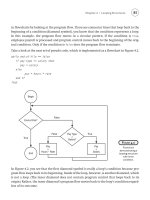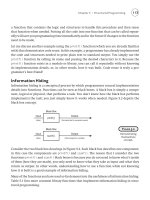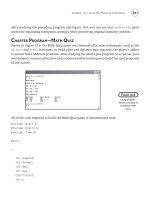Programming Groovy dynamic productivity for the java developer phần 7 pot
Bạn đang xem bản rút gọn của tài liệu. Xem và tải ngay bản đầy đủ của tài liệu tại đây (209.25 KB, 31 trang )
GROOVY OBJECT 187
class implements
GroovyInterceptable?
call it’s invokeMethod()
yes
no
method exists
in MetaClass or
class?
no
yes
Call interceptor or
original method
has a property
with method name?
that property
is of type Closure?
no
call closure’s call() method
has
methodMissing()?
call it’s methodMissing()
has
invokeMethod()?
call it’s invokeMethod()
throw MissingMethodException()
no
yes
yes
yes
no
yes
no
Figure 12.2: How Groovy handles method calls on a POGO
For a POJO, Groovy fetches its MetaClass from the applicationwide Meta-
ClassRegistry and delegates method invocation to it . So, any interceptors
or methods you’ve defined on its MetaClass take precedence over the
original method of the POJO.
For a POGO, Groovy takes a few extra steps, as illustrated in Fig-
ure
12.2. If the object implements GroovyInterceptable, then all calls
are rout ed to its invokeMethod( ). Within this interceptor, you can route
calls to the actual met hod, if you want, allowing you t o do AOP-like
operations.
If the POGO does not implement GroovyInterceptable, then Groovy looks
for the method first in the POGO’s MetaClass and then, if not found, on
GROOVY OBJECT 188
the POGO itself. If the POGO has no such method, Groovy looks for
a property or a field with the method name. If that property or field
is of type closure, Groovy invokes that in place of the method call. If
Groovy finds no such property or field, it makes two last attempts. If
the POGO has a method named methodMi ssi ng( ), it calls it. Otherwise,
it calls the POGO’s invokeMethod(). If you’ve implemented this method
on your POGO, it is used. The default implementation of invokeM ethod()
throws a MissingMethodException indicating the failure of the call.
Let’s see in code the mechanism discussed earlier. I’ve created classes
with different options to illustrate Groovy’s method handlin g. Study
the code, and see whether you can figure out which methods Groovy
executes in each of the cases (while walking through t he following code,
refer t o Figure
12.2, on the precedin g page):
Download ExploringMOP/TestMetho dInvocation.groovy
class TestMethodInvocation extends GroovyTestCase
{
void testMethodCallonPOJO()
{
def val = new Integer(3)
assertEquals
"3"
, val.toString()
}
void testInterceptedMethodCallonPOJO()
{
def val = new Integer(3)
Integer.metaClass.toString = {->
'intercepted'
}
assertEquals
"intercepted"
, val.toString()
}
void testInterceptableCalled()
{
def obj = new AnInterceptable()
assertEquals
'intercepted'
, obj.existingMethod()
assertEquals
'intercepted'
, obj.nonExistingMethod()
}
void testInterceptedExistingMethodCalled()
{
AGroovyObject.metaClass.existingMethod2 = {->
'intercepted'
}
def obj = new AGroovyObject()
assertEquals
'intercepted'
, obj.existingMethod2()
}
GROOVY OBJECT 189
void testUnInterceptedExistingMethodCalled()
{
def obj = new AGroovyObject()
assertEquals
'existingMethod'
, obj.existingMethod()
}
void testPropertyThatIsClosureCalled()
{
def obj = new AGroovyObject()
assertEquals
'closure called'
, obj.closureProp()
}
void testMethodMissingCalledOnlyForNonExistent()
{
def obj = new ClassWithInvokeAndMissingMethod()
assertEquals
'existingMethod'
, obj.existingMethod()
assertEquals
'missing called'
, obj.nonExistingMethod()
}
void testInvokeMethodCalledForOnlyNonExistent()
{
def obj = new ClassWithInvokeOnly()
assertEquals
'existingMethod'
, obj.existingMethod()
assertEquals
'invoke called'
, obj.nonExistingMethod()
}
void testMethodFailsOnNonExistent()
{
def obj = new TestMethodInvocation()
shouldFail (MissingMethodException) { obj.nonExistingMethod() }
}
}
class AnInterceptable implements GroovyInterceptable
{
def existingMethod() {}
def invokeMethod(String name, args) {
'intercepted'
}
}
class AGroovyObject
{
def existingMethod() {
'existingMethod'
}
def existingMethod2() {
'existingMethod2'
}
def closureProp = {
'closure called'
}
}
class ClassWithInvokeAndMissingMethod
{
def existingMethod() {
'existingMethod'
}
def invokeMethod(String name, args) {
'invoke called'
}
def methodMissing(String name, args) {
'missing called'
}
}
QUERYING METHODS AND PROPER TIES 190
class ClassWithInvokeOnly
{
def existingMethod() {
'existingMethod'
}
def invokeMethod(String name, args) {
'invoke called'
}
}
The following output confirms that all the tests pass and Groovy han-
dles the method as discussed:
Time: 0.047
OK (9 tests)
12.2 Querying Methods and Properties
You can find out at runtime if an object supports a cer tain behavior
by querying for its methods and properties. This is especially useful
for behavior you add dynamically at runtime. Groovy allows you to add
behavior not only to classes but also to select instances of a class.
Use getMetaMethod( ) of MetaObjectProtocol
3
to get a metamethod. Use
getStaticMetaMethod( ) i f you’re looking for a static method. Simi l arly,
use getMetaProperty( ) and getStaticMetaProperty( ) for a metaproperty. To
get a list of overloaded methods, use the plural form of these methods—
getMetaMethods( ) and getStaticMetaMethods( ). If you want simply to
check for existence and not get the metamethod or metaproperty, use
hasProperty( ) to check for properti es and respondsTo( ) for methods.
MetaMethod “represents a Method on a Java object a little like Method
except without using reflection to invoke the method,” says the Groovy
documentation. If you have the name of a method as a string, call get-
MetaMethod( ) and use the resulting MetaMethod to invoke your method,
as shown h ere:
Download ExploringMOP/UsingMetaMethod.groovy
str =
"hello"
methodName =
'toUpperCase'
// Name may come from an input instead of being hard coded
methodOfInterest = str.metaClass.getMetaMethod(methodName)
println methodOfInterest.invoke(str)
3. MetaClass extends MetaObjectProtocol.
QUERYING METHODS AND PROPER TIES 191
Here’s the output from the previous code:
HELLO
You don’t have to know a method name at coding time. You can get it
as input and invoke the method dynamically.
To find out whether an object would respond to a method call, use
the respondsTo( ) method. It takes as parameters the instance you’re
querying, the name of the method you’re querying for, and an optional
comma-separated list of arguments intended for that method for which
you’re query i ng. It returns a list of MetaMethods for the matching meth-
ods. Let’s use that in an example:
Download ExploringMOP/UsingMetaMethod.groovy
"Does String respond to toUpperCase()? "
println String.metaClass.respondsTo(str,
'toUpperCase'
)?
'yes'
:
'no'
"Does String respond to compareTo(String)? "
println String.metaClass.respondsTo(str,
'compareTo'
,
"test"
)?
'yes'
:
'no'
"Does String respond to toUpperCase(int)? "
println String.metaClass.respondsTo(str,
'toUpperCase'
, 5)?
'yes'
:
'no'
The output from the previous code is as follows:
Does String respond to toUpperCase()? yes
Does String respond to compareTo(String)? yes
Does String respond to toUpperCase(int)? no
getMetaMethod( ) and respo ndsTo( ) offer a nice convenience. You can sim-
ply send the arguments for a method you’re lookin g for to these meth-
ods. They don’t insist on an array of Class of the arguments like the get-
Method( ) method i n Java reflection. Even better, if the method you’re
interested in does not take any parameters, don’t send any arguments,
not even a null. This is because the last parameter to these methods is
an array of parameters and is treated optional by Groovy.
There was on e more magical thing taking place in the previous code:
you used Groovy’s special treatment of boolean (for more information,
see Section
3.5, Groovy boolean Evaluation, on page 55). The respond-
sTo( ) method returns a list of MetaMethods, and since you used the
result in a conditional statement (the ?: operator), Groovy returned true
if there were any methods and fal se otherw i se. So, you don’t have to
explicitly check whether the size of the retur ned list is greater than
zero. Gr oovy does that for you.
DYNAMICALLY AC CESSING OBJECTS 192
12.3 Dynamically A ccessing Objects
You’ve looked at ways to query for methods and properties and also at
ways to invoke them dynamically. There are other convenient ways to
access proper ties and call methods in Groovy. We will l ook at them now
using an instance of String as an example. Suppose you get the names of
properties and methods as i nput at runtime and want to access these
dynamically. Here are some ways to do that:
Download ExploringMOP/AccessingObject.groovy
def printInfo(obj)
{
// Assume user entered these values from standard input
usrRequestedProperty =
'bytes'
usrRequestedMethod =
'toUpperCase'
println obj[usrRequestedProperty]
//or
println obj.
"$usrRequestedProperty"
println obj.
"$usrRequestedMethod"
()
//or
println obj.invokeMethod(usrRequestedMethod, null)
}
printInfo(
'hello'
)
Here’s the output from the previous code:
[104, 101, 108, 108, 111]
[104, 101, 108, 108, 111]
HELLO
HELLO
To invoke a property dynamically, you can use the index operator [ ]
or use the dot notation followed by a GString evaluating the property
name, as shown in the previous code. To invoke a method, use the dot
notation or call th e invokeMethod on the object, giving it the met hod
name and list of argument s (null in this case).
To iterate over all the properties of an object, use the properties property
(or the getProperties( ) met hod), as shown here:
Download ExploringMOP/AccessingObject.groovy
println
"Properties of 'hello' are: "
'hello'
.properties.each { println it }
DYNAMICALLY AC CESSING OBJECTS 193
The output is as follows:
Properties of
'hello'
are:
empty=false
class=class java.lang.String
bytes=[B@74f2ff9b
In this chapter, you looked at the fundamentals for metaprogramming
in Groovy. With this foundation, you’re wel l equipped to explore MOP
further, understand how Groovy works, and take advantage of the MOP
concepts you’ll see in the next few chapters.
Chapter
13
Intercep tin g Methods Using MOP
In Groovy you can implement Aspect-Oriented Programming (AOP)
[Lad03] like method interception or method advice fairly easily. There
are three types of advi ce. And, no, I’m not talking about the good advice,
the bad advice, and the unsolicited advice we receive every day. I’m
talking about the before, after, and around advice. The before advice
is code or a concern you’d want to execute before a certai n operation.
After advice is executed after the execution of an operation. The around
advice, on the other hand, is executed instead of th e intended opera-
tion. You can use MOP to implement these advices or interceptors. You
don’t need any complex tools or frameworks to do that in Groovy.
There are two approaches in Groovy to intercept met hod calls: either
let the object do it or let its M etaClass do it. If you want the object to
handle it, you need to implement the GroovyInterceptable interface. This
is not desirable if you’re not the author of the class, if t he class is a
Java class, or if you want to introduce interception dynamically. The
second approach is better in these cases. You’ll look at both of these
approaches in this chapter.
1
13.1 Intercepting Met hods Using G roovyInterceptable
If a Groovy object implements GroovyInterceptable, then its invoke-
Method( ) is called when any of i ts methods are called—both existing
methods an d nonexisting methods. That is, GroovyInterceptable ’s invoke-
Method( ) hijacks all calls to the object.
1. There’s one more way to intercept methods, using categories, but I’ll defer discussing
that until Section
14.1, Injecti ng Methods Using Cate gories, on page 203.
INTERCEPTING METHODS USING GROOVYINTERCEPTABLE 195
invokeMethod, GroovyInterceptable, and GroovyObject
If a Groovy object implements the GroovyInterceptable inter-
face, th en its invokeMeth o d( ) is called for all its method calls.
For other Groovy objects, it is called only for m ethods that are
nonexistent at the time of call. The exception to this is if you
implement invokeMethod( ) on its MetaClass. In that case, it is
again called always for both types of methods.
If you want to perform an around advice, simply implement your logic
in this method, and you’r e done. However, if you want to implement
the before or after advice (or both), implement your before/after logic,
and route the call to the actual method at the appropriate time. To
route the call, use the MetaMethod for the method you can obtain from
the M etaClass (see Section
12.2, Querying Methods and Properties, on
page
190).
Suppose you want to run filters—such as validation, login verification,
logging, and so on—before you run some methods of a class. You don’t
want to manuall y edit each method to call the filters because such
effort is redundant, tedious, and error prone. You don’t wan t to ask
callers of your methods to invoke the filters either, because there’s no
guarantee they’ll call. Intercepting method calls to apply the filters is a
good option. It’ll be seamless and automatic.
Let’s look at an example
2
in whi ch you want to run check( ) on a Car
before any other method is executed. Here’s the code that uses Groovy-
Interceptable to achieve this:
Download InterceptingMethodsUsingMOP/InterceptingCalls.groovy
Line 1
class Car implements GroovyInterceptable
-
{
-
def check() { System.out.println
"check called "
}
-
5
def start() { System.out.println
"start called "
}
-
-
def drive() { System.out.println
"drive called "
}
-
2. I’ll use System.out.println() instead of println() in the example s in this chapter to avoid the
interception of infor mational print messages.
INTERCEPTING METHODS USING GROOVYINTERCEPTABLE 196
-
def invokeMethod(String name, args)
10
{
-
System.out.print(
"Call to $name intercepted "
)
-
-
if (name !=
'check'
)
-
{
15
System.out.print(
"running filter "
)
-
Car.metaClass.getMetaMethod(
'check'
).invoke(this, null)
-
}
-
-
def validMethod = Car.metaClass.getMetaMethod(name, args)
20
if (validMethod != null)
-
{
-
validMethod.invoke(this, args)
-
}
-
else
25
{
-
return Car.metaClass.invokeMethod(this, name, args)
-
}
-
}
-
}
30
-
car = new Car()
-
-
car.start()
-
car.drive()
35
car.check()
-
try
-
{
-
car.speed()
-
}
40
catch(Exception ex)
-
{
-
println ex
-
}
Here’s the output from the previous code:
Call to start intercepted running filter check called
start called
Call to drive intercepted running filter check called
drive called
Call to check intercepted check called
Call to speed intercepted running filter check called
groovy.lang.MissingMethodException:
No signature of method: Car.speed()
is applicable for argument types: () values: {}
Since Car i mplements GroovyInterceptable, all method calls on an in-
stance of Car are intercepted by its invokeMethod( ). In that method, i f
the method name is not check, you invoke the before filter, which is the
INTERCEPTING METHODS USING METACLASS 197
check( ) method. Determine whet her the method called is a valid existing
method with the help of the MetaClass’s getMetaMethod( ). If t he method
is valid, call that method using the invoke() method of the MetaMe thod,
as on line number 22.
If the meth od is not found, simply route the r equest to the MetaClass,
as on line number 26. This gives an opportunity for the method to be
synthesized dynamically, as you’ll see in Section
14.4, Method Synthe-
sis Using methodMissing, on page 214. If the method does not exist,
MetaClass’s invokeMethod() will throw a MissingMethodException.
In this example, you created a before advice. You can easily create
an after advice by placing the desired code after line number 22. If
you want to implement around advice, then eliminate the code on line
number 22.
13.2 Intercepting Met hods Using M etaClass
You used GroovyInterceptable to intercept method calls in Section
13.1,
Intercepting Methods Using GroovyInterceptable, on page
194. That ap-
proach is good if you’re the author of the class whose methods you want
to intercept. However, that appr oach won’t work if you don’t have the
privileges to modify the class source code or if it is a Java class. Fur-
thermore, you may decide at runtime to start interceptin g calls based
on some condition or application state. In these cases, intercept meth-
ods by implementing the invokeMethod() method on the MetaClass.
Let’s rewrite the example from Section
13.1, Intercepting Methods Using
GroovyInterceptable, on page 194, this time using the MetaClass. In th i s
version, the Car does not implement GroovyInterceptable and does not
have the invokeMetho d( ):
3
Download InterceptingMethodsUsingMOP/InterceptingCallsUsingMeta Class.groovy
Line 1
class Car
-
{
-
def check() { System.out.println
"check called "
}
-
5
def start() { System.out.println
"start called "
}
-
-
def drive() { System.out.println
"drive called "
}
-
}
-
3. Even if it has invokeMethod( ), the invokeMethod( ) you add to Met aClass ta kes precedence
if Car does not implement GroovyInterceptable.
INTERCEPTING METHODS USING METACLASS 198
10
Car.metaClass.invokeMethod = { String name, args ->
-
System.out.print(
"Call to $name intercepted "
)
-
-
if (name !=
'check'
)
-
{
15
System.out.print(
"running filter "
)
-
Car.metaClass.getMetaMethod(
'check'
).invoke(delegate, null)
-
}
-
-
def validMethod = Car.metaClass.getMetaMethod(name, args)
20
if (validMethod != null)
-
{
-
validMethod.invoke(delegate, args)
-
}
-
else
25
{
-
return Car.metaClass.invokeMissingMethod(delegate, name, args)
-
}
-
}
-
30
-
car = new Car()
-
-
car.start()
-
car.drive()
35
car.check()
-
try
-
{
-
car.speed()
-
}
40
catch(Exception ex)
-
{
-
println ex
-
}
The output from the previous code is as follows:
Call to start intercepted running filter check called
start called
Call to drive intercepted running filter check called
drive called
Call to check intercepted check called
Call to speed intercepted running filter check called
groovy.lang.MissingMethodException:
No signature of method: Car.speed()
is applicable for argument types: () values: {}
On lin e number 10, you implemented, in the form of a closure, the
invokeMethod( ) and set it on Car’s MetaClass. This method will now inter-
cept all calls on an instance of Car. There are two differences between
this version of invo keMethod() and the version you implemen ted on
INTERCEPTING METHODS USING METACLASS 199
Car in Section 13.1, Intercepting Methods Using GroovyInterceptable,
on page 194. The first difference is the use of delegate instead of this
(see line number 16, for example). The delegate within the intercepting
closure refers to the target object whose methods are being intercepted.
The second difference is on line number 26, where you call invokeMissing-
Method( ) on the MetaClass instead of calling i nvokeMethod. Since y ou’re
already in invokeMethod( ), you should not call it recur sively here.
As I mentioned earlier, one nice aspect of using the MetaClass to i nter-
cept calls is you can intercept calls on POJOs as well. To see this in
action, let’s intercept calls to methods on an Integer and perform AOP-
like advice:
Download InterceptingMethodsUsingMOP/InterceptInteger.groovy
Integer.metaClass.invokeMethod = { String name, args ->
System.out.println(
"Call to $name intercepted on $delegate "
)
def validMethod = Integer.metaClass.getMetaMethod(name, args)
if (validMethod == null)
{
return Integer.metaClass.invokeMissingMethod(delegate, name, args)
}
System.out.
println(
"running pre-filter "
)
result = validMethod.invoke(delegate, args)
// Remove this for around-advice
System.out.println(
"running post-filter "
)
result
}
println 5.floatValue()
println 5.intValue()
try
{
println 5.empty()
}
catch(Exception ex)
{
println ex
}
The output from the previous code is as follows:
Call to floatValue intercepted on 5
running pre-filter
running post-filter
5.0
INTERCEPTING METHODS USING METACLASS 200
Call to intValue intercepted on 5
running pre-filter
running post-filter
5
Call to empty intercepted on 5
groovy.lang.MissingMethodException:
No signature of method: java.lang.Integer.empty()
is applicable for argument types: () values: {}
The invokeMethod( ) you added on the MetaClass of Integer intercepts
method calls on 5, an instance of Integer. To intercept calls on any
Object and not only Inte gers, add the interceptor to Object’s MetaClass.
If you’re interested in intercepting calls only to nonexistent methods,
then use methodMissi ng( ) instead of invokeMethod(). We’ll discuss this in
Chapter
14, MOP Method Injection and Synthesis, on page 202.
You can provide both invokeMethod( ) and metho dMissing() on MetaClass.
invokeMethod( ) takes precedence over methodMissing( ) . However, by call-
ing invokeMissingMethod( ), you’re letting methodMissin g( ) handle nonex-
isting methods.
The ability to intercept method calls using MetaClass was influenced by
Grails. It w as originally introduced in Grails
4
and was later moved into
Groovy. Take a minute to examine the MetaClass that’s giving you so
much power:
Download InterceptingMethodsUsingMOP/ExamineMetaClass . groovy
println Integer.metaClass.getClass().name
The output from the previous code is as follows:
groovy.lang.ExpandoMetaClass
ExpandoMetaClass is an implementation of the MetaClass interface and is
one of the key classes responsible for implementing dynamic behavior
in Groovy. You can add methods to this class to inject behavior into
your class, and you can even specialize individual objects using this
class.
There is a gotcha here depending on ExpandoMetaClass. It is one among
different implementations of MetaClass. By default, Groovy currentl y
does not use Ex p andoMetaClass. When y ou query for the metaClass, how-
ever, the default is replaced with an instance of ExpandoMetaClass.
4. See />INTERCEPTING METHODS USING METACLASS 201
Here’s an example that shows thi s behavior:
Download InterceptingMethodsUsingMOP/MetaClassUsed.groovy
class MyClass {}
println
"MetaClass of 2 is "
+ 2.metaClass.getClass().name
println
"MetaClass of Integer is "
+ Integer.metaClass.getClass().name
println
"MetaClass of 2 now is "
+ 2.metaClass.getClass().name
obj1 =
new MyClass()
println
"MetaClass of obj1 is "
+ obj1.metaClass.getClass().name
println
"MetaClass of MyClass is "
+ MyClass.metaClass.getClass().name
println
"MetaClass of obj1 still is "
+ obj1.metaClass.getClass().name
obj2 = new MyClass()
println
"MetaClass of obj2 created later is "
+ obj2.metaClass.getClass().name
The output from the previous code is as follows:
MetaClass of 2 is groovy.lang.MetaClassImpl
MetaClass of Integer is groovy.lang.ExpandoMetaClass
MetaClass of 2 now is groovy.lang.ExpandoMetaClass
MetaClass of obj1 is groovy.lang.MetaClassImpl
MetaClass of MyClass is groovy.lang.ExpandoMetaClass
MetaClass of obj1 still is groovy.lang.MetaClassImpl
MetaClass of obj2 created later is groovy.lang.ExpandoMetaClass
To begin with, the metaclass of In teger was an instance of MetaClas-
sImpl. When you query for the metaClass property, it is replaced with
an instance of ExpandoMetaClass. For your own Groovy classes, th e
MetaClass used for instances created before you query for metaClass on
your class is different from the instances created after you query.
5
This
behavior has caused some surprises when working wi th metaprogram-
ming.
6
It would be nice if Groovy consistently used ExpandoMetaClass as
the default implementation. There are discussions about this change in
the Gr oovy community.
In this chapter, you saw how to intercept methods calls to realize AOP-
like method advice capabilities. You’ll find this feature useful to mock
methods for the sake of testing, temporari l y replace problem methods,
study alternate implementations for algorithms without ha vin g to mod-
ify existing code, and more. You can g o fur ther with MOP by adding
methods dynamically as well. You’ll explore t his in the next chapter.
5. Groovy allows each POGO to be associated with its own instance of MetaClass. This
gives you the advantage of refining speci fic instances, as you’ll see in Chapter
14, MOP
Method Injection and Synthesis, on the next page.
6. You can find examples in Section 14.2, Injecting Method s Using ExpandoMetaClass,
on page 208 and in Section 14.4, Method Synthesis U sing methodMissing, on page 214.
Chapter
14
MOP Method Injection
and Syn thesis
In Groovy you can open a class at any time. That is, you can add meth-
ods to classes dynamically, allowing them to change behavior at run-
time. Rather than working with a static str ucture and predefined set of
methods, objects can be agile, flexible, and assimilate behavior based
on what’s going on i n your application. You can add a method based
on a certain input you receive, for example. The ability to modify the
behavior of your classes is central to metaprogramming and Groovy’s
MOP.
Using Groovy’s MOP, you can inject behavior in one of several ways.
You can use the following:
• Categories
• ExpandoMetaClass
• GroovyInterceptable
• GroovyObject’s invokeMethod()
• GroovyObject’s methodMissing( )
I separate adding behavior into two types: injection and synthesis.
I’ll use th e term method injection to refer to the case in w hich at code-
writing time you know the names of methods you want to add t o one
more more classes. Method injection allows you to add behavior dynam-
ically into classes. You can add a set of reusable methods—like util-
ity functions—that represent a certain functionality, to any number of
classes. You can inject methods either by using categories or by using
ExpandoMetaClass.
INJECTING METHODS USING CATEGORIES 203
On the oth er hand, method synthesis will refer to the case in which you
want t o dynamically figure out the behavior for methods upon invoca-
tion. Groovy’s invokeM ethod(), methodMissing( ), and GroovyInterceptable
are useful for method synthesis. For example, Grails/GORM synthe-
sizes finder methods like findByFirstName( ) and findByFirstNameAndLast-
Name( ) for domain objects upon invocation.
A synthesized method may not exist as a separate method until you
call it. When you call a nonexistent method, Groovy can intercept th e
call, allow your application to implement it on the fly, let you cache
that implementation for future invocation, and then invoke it—Graeme
Rocher calls i t the “Intercept, Cache, Invoke” pattern.
In this chapter, you’ll learn about MOP facilities for method injection
and method synthesis.
14.1 Injecting Methods Using Categories
Groovy categories provide a controlled w ay to inject methods—the effect
of method injection is contained within a block of code. A category is
an object that has the ability to alter your class’s MetaClass. It does so
within the scope of the block and the executing thread. It reverses the
change when you exit the block. Categories can be nested, and you can
also apply multiple categories in a single block. You will explore the
behavior and use of categories using examples in th i s section.
Suppose you have a Social Security number in a Strin g or StringBuffer.
You want to inject a method toSSN( ) that wi l l return the str i ng in the
format xxx-xx-xxxx. Let’s discuss some ways to achieve this.
Say the first pl an of attack is to create a class SSNStringBuil der that
extends StringBuffer and write the method toSSN( ) in it. Unfortunately,
users of Stri ngBuffer won’t have this method. It’s available only on SSN-
StringBuilder. Also, you can’t extend the final class String, so you don’t
have this method on it.
Instead, take advantage of Groovy’s categories by creating a class String-
Util and adding a static method toSSN( ) in it. This method takes one
parameter, the target object on which the method is to be injected.
The met hod checks t he size of the string and returns a string in the
intended format. To use the new method, call a special method use( )
that takes two parameters: a category and a closure block of code within
which the injected method(s) are in effect.
INJECTING METHODS USING CATEGORIES 204
The code is as f ollows:
Download InjectionAndSynthesisWithMOP/UsingCategories.groovy
class StringUtil
{
def static toSSN(self) //write toSSN(String self) to restrict to String
{
if (self.size() == 9)
{
return
"${self[0 2]}-${self[3 4]}-${self[5 8]}"
}
}
}
use(StringUtil)
{
println
"123456789"
.toSSN()
println new StringBuffer(
"987654321"
).toSSN()
}
try
{
println
"123456789"
.toSSN()
}
catch(MissingMethodException ex)
{
println ex.message
}
Here’s the output from the previous code:
123-45-6789
987-65-4321
No signature of method: java.lang.String.toSSN()
is applicable for argument types: () values: {}
The method you injected is available only within the use block. When
you called toSSN( ) outside the block, you got a M i ssi ngMethodException.
The calls to toSSN( ) on instances of String and StringBuffer within the block
are routed to the stat i c method in the category StringUtil. The parameter
self of toSSN( ) is assigned to the target inst ance. Since you did not define
the type of the self parameter, its type defaults to Object, and toSSN( )
is available on any object. If you wan t to restrict it to only Strings and
StringBuffers, you will have to create two versions of toSSN( ) with explicit
parameter types, one with String self and the other wit h StringBuffer self.
Groovy categories require the injection method to be static and take
at least one parameter. The first parameter ( called self i n this exam-
ple) refers to the targ et of the method call. Any parameters t hat your
INJECTING METHODS USING CATEGORIES 205
injected method takes will trail. The parameters can be any legal Groovy
parameters—objects and closures.
Let’s take a moment to understand the magic that happened when you
called use( ) in the previous exampl e. Groovy routes calls to the use( )
method i n your script to the public static Object use(Class categoryClass,
Closure closure) method of the GroovyCategorySupport class. This method
defines a new scope—a fresh property/method list on the stack for the
target objects’ MetaClass. It then examines each of the static methods
in the given category class and adds its static methods with at least
one parameter to the property/method l i st. Finally, it calls the closure
attached. Any method calls from within the closure are intercepted and
sent to th e implementation provided by the category, if present. This is
true for new methods you add and existing methods that you’re inter-
cepting. Finally, upon return from the closure, use( ) ends the scope
created earlier, discarding the inj ect ed methods in the category.
Injected methods can take objects and closures as parameters. Here is
an example to show that. Let’s write another category FindUtil. Here you
are providing a method called extractOnly( ) that will extract part of a
string specified by a closure parameter to it:
Download InjectionAndSynthesisWithMOP/UsingCategories.groovy
class FindUtil
{
def static extractOnly(String self, closure)
{
def result =
''
self.each {
if (closure(it)) { result += it }
}
result
}
}
use(FindUtil)
{
println
"121254123"
.extractOnly { it ==
'4'
|| it ==
'5'
}
}
The result of the previous call is as follows:
54
INJECTING METHODS USING CATEGORIES 206
Built-in Categories
Groovy comes with a couple of categories to make our lives
easier. DOMCategory (see Section
9.1, Using DOMCategory, on
page 156) all ows you to treat DOM objects like JavaBeans and
use Groovy path expressions (GPath) (see Section 9.1, Using
XMLParser, on page
158). ServletCategory allows you to use
Servlet API objects’ attributes using the JavaBeans convention.
You can apply more than one category at the same time—to bring in
multiple sets of methods. use( ) takes either one category or a list of
categories. Here’s an example to use both the categories you created
earlier:
Download InjectionAndSynthesisWithMOP/UsingCategories.groovy
use(StringUtil, FindUtil)
{
str =
"123487651"
println str.toSSN()
println str.extractOnly { it ==
'8'
|| it ==
'1'
}
}
The output from the previous code is as follows:
123-48-7651
181
Even though use( ) takes a List of Class instances, Groovy is quite happy to
accept a comma-separated list of class names. This is because Groovy
turns the name of a class, once defined, into a reference to the Class
metaobject; e.g ., String is equivalent to String.class, in other words, String
== String.class.
When you mix multiple categori es, the obvious question is about the
order in which method calls get resolved when there is a meth od name
collision. The last category in the list takes the highest precedence.
Groovy allows you to nest calls to use. That is, you can call use( ) from
within a closure of another call to use( ). An inner cat egory takes prece-
dence over the outer.
So far, you’ve seen how to inject n ew methods into an exi sting class.
In Chapter
13, Intercepting Methods Using MOP, on page 194, you saw
ways to intercept existing methods. You can use categories for that
INJECTING METHODS USING CATEGORIES 207
as well. Suppose you want to intercept calls to toString( ) and pad the
response with two exclamations on each side. Here’s h ow to do that
using categories:
Download InjectionAndSynthesisWithMOP/UsingCategories.groovy
class Helper
{
def static toString(String self)
{
def method = self.metaClass.methods.find { it.name ==
'toString'
}
'!!'
+ method.invoke(self, null) +
'!!'
}
}
use(Helper) {
println
'hello'
.toString()
}
The output from the previous code is as follows:
!!hello!!
The Hel p er’s toString( ) is used to intercept calls to that method on String
“hello.” However, within this interceptor, you want to call the original
toString( ). You get access to it using the MetaClass of String.
Using categories for meth od interception is not as elegant as the other
approaches you saw in Chapter
13, Intercepting Methods Using MOP, on
page 194. You can’t use it for filtering all method calls to an instance.
You’l l have to write separate methods for each method you want t o
intercept. Also, when you have nested categories, you can’t reach into
the interception of the top-level categories. Use categories for method
injection, but not for meth od inter ception.
Categories provide a nice method injection protocol. Their effect is con-
tained within the flow of control in the use block. You leave the block,
and the injected methods disappear. When you receive a parameter on
your methods, you can apply y our own categories to that parameter. It
feels like you augmented the type of the obj ect you received. When you
leave your method, you’re returning the object wi th its class unaff ect ed.
You can implement different versions of intercepted/inj ected methods
by using different categories.
Categories have some limitation s, however. Their effect is contained
within th e use( ) block and hence limited to the executing thread. So,
injected methods are restricted. Existing methods can be called from
anywhere, but injected methods have to be called within the block. If
INJECTING METHODS USING EXPANDOMETACLASS 208
you enter and exit the block multiple times, there is overhead. Each
time you enter, Groovy has to examine static methods and add them t o
a method list in the new scope. At the end of the block, it has to clean
up the scope.
If th e calls are not too frequent and you want the isolation that con-
trolled method i njection categories provide, use th em. If those features
turn into limitations, use ExpandoMetaClass for inj ect i ng methods. We’ll
discuss that next.
14.2 Injecting Methods Using ExpandoMetaClass
If you want to create DSLs, you need to be able to add arbitrary meth-
ods to different classes and even hierarchies of classes. You need to
inject instance methods and static methods, manipulate constructors,
and convert a method to a property for the sake of fluency. You’ll want
these capabilities if you want to create mock objects to st and in for
collaborators. In this section, you’ll learn the tech niques to alter and
enhance the struct ure of a class.
You can inject methods into a class by adding methods to its MetaClass.
The methods you inject are available globally . You’re not restricted
to a block like in categories. (I discussed ExpandoMetaClass in Sec-
tion
13.2, Intercepting Methods Using MetaClass, on page 197.) Using
ExpandoMetaClass, you can add methods, properties, constructors, and
static methods, and you can even borrow met hods from other classes.
You can use it to inject methods into POGOs and POJOs.
Let’s look at an exampl e of using ExpandoMetaClass to inject a method
called daysFromNow( ) into Integer. You want t he statement 5.daysFrom-
Now() to return the date five days from today. Here’s the code:
Download InjectionAndSynthesisWithMOP/UsingExpandoMetaClass.groovy
Integer.metaClass.daysFromNow = { ->
Calendar today = Calendar.instance
today.add(Calendar.DAY_OF_MONTH, delegate)
today.time
}
println 5.daysFromNow()
The pr evious code reports the following:
Thu Dec 20 13:16:03 MST 2007
INJECTING METHODS USING EXPANDOMETACLASS 209
In this code, you implemented daysFromNow( ) using a closure and intro-
duced that into the MetaClass of Integer. (To inject the method on any
object, add it to MetaClass of Object.) Within the closure, you need to get
access to the target object of Integer. The delegate refers to the target .
See Section
5.8, Closure Delegation, on page 107 and Section 8.1, Object
Extensions, on page 141 for discussions on delegate and closures.
If you want, dr op that parentheses at the end of the method call t o
make it fluent (see Section
18.2, Fluency, on page 279) so you can
call 5.daysFromNow. However, this needs a little trick ( see Section 18.8,
The Parentheses Limitation and a Workaround, on page 285). Basically,
you need t o set up a property instead of method because without the
parentheses Groovy thinks it’s a property and not a method. To define
a property named daysFromNow, you have to create a method named
getDaysFromNow( ), so let’s do that:
Download InjectionAndSynthesisWithMOP/UsingExpandoMetaClass.groovy
Integer.metaClass.getDaysFromNow = { ->
Calendar today = Calendar.instance
today.add(Calendar.DAY_OF_MONTH, delegate)
today.time
}
println 5.daysFromNow
The output fr om the previous code is shown next. The call to the prop-
erty daysFromNow is now routed to the method getDaysFromNow( ).
Thu Dec 20 13:16:03 MST 2007
You injected a method on Integer, but what about its cousins Short and
Long? The previous method is not available on these classes. You cer-
tainly don’t want to redundantly add the method to those classes. One
idea is to store the closure in a variable and then assign it t o t hese
classes, as shown here:
Download InjectionAndSynthesisWithMOP/MethodOnHierarchy.groovy
daysFromNow = { ->
Calendar today = Calendar.instance
today.add(Calendar.DAY_OF_MONTH, (
int)delegate)
today.time
}
Integer.metaClass.daysFromNow = daysFromNow
Long.metaClass.daysFromNow = daysFromNow
println 5.daysFromNow()
println 5L.daysFromNow()
INJECTING METHODS USING EXPANDOMETACLASS 210
The output is as follows:
Thu Dec 20 13:26:43 MST 2007
Thu Dec 20 13:26:43 MST 2007
Alternately, you can provide the method in the base class Number of
Integer. Let’s add a method named someMethod( ) on Number and see
whether it’s available on Integer and Long:
1
Download InjectionAndSynthesisWithMOP/MethodOnHierarchy.groovy
Integer.metaClass
Long.metaClass
// Above statements will not be needed if
// ExpandoMetaClass was the default MetaClass
// in Groovy.
Number.metaClass.someMethod = { ->
println
"someMethod called"
}
2.someMethod()
2L.someMethod()
The output from the previous code, shown here, confirms that the
methods are available on the derived classes:
someMethod called
someMethod called
You saw how to in j ect a method into a class hierarchy . You might also
want to introduce methods into an interface hierarchy so the methods
are available on all classes implementing that interface.
When you add a method at the interface level, the met hod needs to
be in j ect ed into the MetaClass for each of th e implementing classes.
That happens in Groovy only if enableGlobally( ) of ExpandoMetaClass has
been called already. However, be aw are that turning that flag on will
increase the demand on memory. You’ll take a look at adding a method
to an interface later in Section
18.10, ExpandoMetaClass and DSLs, on
page
289.
You can inject static methods into a class as well. You add static meth-
ods to the static property of the MetaClass.
1. This is an example of the effect of ExpandoMetaClass not being the defa ult MetaCla ss. For
more information, see Section 13.2, Intercepting Methods Using MetaClass, on page 197.
INJECTING METHODS USING EXPANDOMETACLASS 211
Let’s add a static method isEven( ) to Integer:
Download InjectionAndSynthesisWithMOP/UsingExpandoMetaClass.groovy
Integer.metaClass.static.isEven = { val -> val % 2 == 0 }
println
"Is 2 even? "
+ Integer.isEven(2)
println
"Is 3 even? "
+ Integer.isEven(3)
The output from the previous code is as follows:
Is 2 even? true
Is 3 even? false
You figured how to inject instance methods and static methods. The
thir d type of method a class can h ave is the constructor. You can add
constructors as well by defining a special property with the name con-
structor. Since you’re adding a constructor and not replacing an existing
one, you’d use the << operator.
2
Let’s introduce a constructor for Integer
that accepts a Calendar so the instance will hold the number of days as
of that date:
Download InjectionAndSynthesisWithMOP/UsingExpandoMetaClass.groovy
Integer.metaClass.constructor << { Calendar calendar ->
new Integer(calendar.get(Calendar.DAY_OF_YEAR))
}
println new Integer(Calendar.instance)
The output from the previous code is as follows:
349
In the injected constructor you are using the existing constructor of
Integer that accepts an int. You could have returned the result of call
to Calendar’s get( ) instead of creating a new instance of Integer. In that
case, autoboxin g wi l l take care of creating an Integer instance. Make
sure that your implementation doesn’t recursively call itself, leading to
a StackOverflowError.
Instead of adding a new constructor, if you want to replace (or override,
though strictly speaking constructors are not overr i dable) a construc-
tor, you can do that by using the = operator instead of the << operator.
2. Using << to override existin g constructors or me thods wi l l result in an error.









